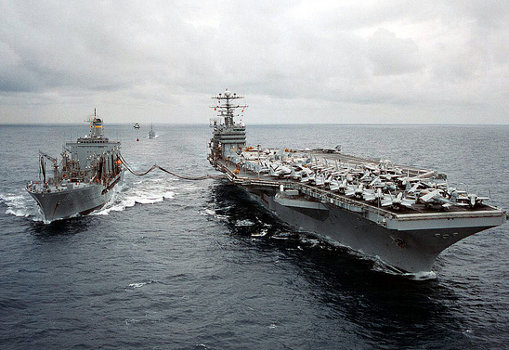December 5, 2011


The Pentagon announced it would “develop more energy-efficient weapons, embrace non-oil energy sources and demand more energy-conscious behavior from the troops.” This move towards energy efficiency in all the branches of the military was mandated by congressional directives and presidential orders, many dating to former President George W. Bush and expanded on by President Barack Obama. (Photo by ExpertInfantry, Flickr)
[nggallery id=69 template=carousel images=4] [imagebrowser id=69] By Debra Atlas
The armed forces are moving quickly to become more energy efficient, as they realize that saving energy will save soldiers’ lives.The Pentagon says that it aims to “develop more energy-efficient weapons, embrace non-oil energy sources, and demand more energy-conscious behavior from the troops.” This move towards energy efficiency in all the branches of the military was mandated by congressional directives and presidential orders, many dating to former President George W. Bush and expanded on by President Barack Obama.
“The cost of energy has become a critical aspect of military operations,” says Anthony Cordesman, a defense analyst with the Center for Strategic and International Studies in Washington.
The chief factor surrounding this is the cost involved in procuring and obtaining oil, which encompasses more than dollars. During World War II, supporting one soldier on the battlefield took a single gallon of fuel per day. Today, we use more than 22 gallons per day per soldier. In 2007, in order to support the 300,000 troops and contractors in Iraq, it took around 1,000 trucks a day and 35,400 troops dedicated only to moving fuel. The journey those trucks made could take weeks to deliver fuel along winding roads to remote bases, leaving them open to terrorist attacks. One out of eight U.S. Army casualties in Iraq was the result of protecting fuel convoys.
“Saving energy saves lives,” says Army Gen. Martin E. Dempsey. “In Afghanistan, fewer supply convoys will directly relate to fewer casualties.”
One major use for this fuel has been to continuously air condition the thin-walled tents used by soldiers in the desert heat that can reach 120 degrees Farenheit. The Army’s Rapid Equipping Force developed a way to insulate those tents, using closed-cell spray polyurethane foam that is sprayed on the exterior of tents. This single, energy-saving step took 11,000 trucks off the roads in Iraq and, as of 2010, saved an estimated $1 billion.
If you think war-related fuel is about the same high price as we pay here in the States, think again. By the time it is delivered through mountainous roads in Afghanistan, the cost can be as high as $200, $300, even $400 a gallon! That makes it even more crucial that the military adopts green practices.
The Navy set a goal that at least 50 percent of its total energy, both at shore and at sea, will come from alternatives to fossil fuel by 2020. It already has certified helicopters that run on biofuels and is testing surface ships that run on biofuels as well. The Navy is also experimenting with wave and tidal power. It is utilizing a surfboard-shaped, wave-powered robot from Liquid Robotics that can be used to monitor the high seas at a significantly cheaper price than using a ship.
With the goal to have at least half of their bases be at net zero by 2020 in mind, the Marines are using smart meters paid for using federal stimulus money at their Experimental Forward Operating Base (ExFOB) located deep in the southern California desert. The smart meters run on solar to heat and cool as well as to manage water purification. The ExFOB also utilizes wind and geothermal.
The Marines also are looking into creating biofuel from trash and garbage. And in 2010, they purchased portable solar panels that roll up like mats and can be stuffed into backpacks. The mats were instrumental in reducing the number of batteries they had to carry to run radios or laptops in Afghanistan. They hope to cut their fuel consumption by 50 percent before 2025.
The Air Force has a long history of incorporating biofuels as part of its fuel mix in planes, including second-generation fuels from algae and other inedible plants.
Buildings are big energy drainers. For the military, any new large building or structure constructed on a military base must qualify for LEED (Leadership in Energy and Environmental Design) certification. Langley Air Force Base has installed a “direct digital control system” that allows personnel to monitor energy usage and performance.
“It’s not really a new technology,” says Don White, Langley’s energy manager. “But getting the military to accept and understand it, well, that took about eight years.”
Change does not come easy to the military. But weighed against the cost of lives and a huge financial burden, being energy efficient simply makes sense.
“Whatever and whenever our forces go into harm’s way, they must have the best tools available,” General Dempsey says. “Improving our energy security can help us do that, and we don’t have the time to waste.”
Check out more articles by Debra Atlas.
© 2011 SCGH, LLC.
]]>